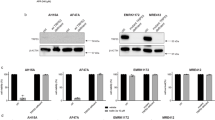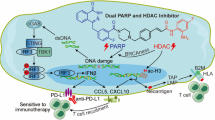Abstract
Background
Suppression of apoptosis is central to the development of cancer and is associated with resistance to modern adjuvant treatments. Therefore, molecules and pathways of apoptotic processes are critical targets for the development of anti-cancer therapeutics. Since apoptosis is executed by intracellular proteins, molecular approaches must incorporate a method to deliver the treatment into the tumor cells.
Methods
We utilized a peptide that contains two domains, a peptide transduction domain derived from the HIV-1 TAT protein and a biological effector domain, the BH3 domain from the pro-apoptotic Bcl-2 family member Bim. We examined whether this construct (TAT-Bim) induced apoptosis in several cancer cell lines (T-cell lymphoma (EL4), pancreatic cancer (Panc-02), and melanoma (B16)) and whether TAT-Bim treatment synergized with radiation. A mutant TAT-Bim peptide with no biologic activity (TAT-Bim-inactive) was used as a control. C57/BL6 mice were challenged with syngeneic cancer cell lines and the effects of intratumoral TAT-Bim injection on tumor growth and host survival were determined.
Results
TAT-Bim was internalized by all cancer cells within two hours. TAT-Bim resulted in apoptosis in a dose dependent fashion in all cell lines and sublethal irradiation augmented the effects of TAT-Bim induced apoptosis. TAT-Bim significantly slowed tumor growth in murine models of pancreatic cancer and melanoma.
Conclusion
TAT-Bim exemplifies a strategy for cancer therapy that involves inducing apoptosis by antagonizing the endogenous anti-apoptotic machinery. Small peptide therapeutics, in combination with traditional adjuvant therapies such as radiation, may provide a valuable ‘second hit’ and drive tumor cells into programmed cell death.




Similar content being viewed by others
References
Prochazkova J, Lichnovsky V, Kylarova D, Erdosova B, Vranka P. Involvement of p53 and Bcl-2 family proteins in regulating programmed cell death and proliferation in human embryogenesis. Gen Physiol Biophys 2004; 23:209–229
Danial NN, Korsmeyer SJ. Cell death: critical control points. Cell 2004; 116:205–219
Ramenghi U, Bonissoni S, Migliaretti G, DeFranco S, Bottarel F, Gambaruto C, Difranco D, Priori R, Conti F, Dianzani I, Valesini G, Merletti F, Dianzani U. Deficiency of the Fas apoptosis pathway without Fas gene mutations is a familial trait predisposing to development of autoimmune diseases and cancer. Blood 2000; 95:3176–3182
Zhou T, Edwards CK III, Yang P, Wang Z, Bluethmann H, Mountz JD. Greatly accelerated lymphadenopathy and autoimmune disease in lpr mice lacking tumor necrosis factor receptor I. J Immunol 1996; 156:2661–2665
Deigner HP, Haberkorn U, Kinscherf R. Apoptosis modulators in the therapy of neurodegenerative diseases. Expert Opin Investig Drugs 2000; 9:747–764
Aggarwal BB, Shishodia S, Ashikawa K, Bharti AC. The role of TNF and its family members in inflammation and cancer: lessons from gene deletion. Curr Drug Targets Inflamm Allergy 2002; 1:327–341
Denlinger CE, Rundall BK, Jones DR. Modulation of antiapoptotic cell signaling pathways in non-small cell lung cancer: the role of NF-kappaB. Semin Thorac Cardiovasc Surg 2004; 16:28–39
Debatin KM, Krammer PH. Death receptors in chemotherapy and cancer. Oncogene 2004; 23:2950–2966
Bergman PJ, Harris D. Radioresistance, chemoresistance, and apoptosis resistance. The past, present, and future. Vet Clin North Am Small Anim Pract 1997; 27:47–57
Tan TT, Degenhardt K, Nelson DA, Beaudoin B, Nieves-Neira W, Bouillet P, Villunger A, Adams JM, White E. Key roles of BIM-driven apoptosis in epithelial tumors and rational chemotherapy. Cancer Cell 2005; 7:227–238
Decaudin D, Marzo I, Brenner C, Kroemer G. Mitochondria in chemotherapy-induced apoptosis: a prospective novel target of cancer therapy (review). Int J Oncol 1998; 12:141–152
Piro LD. Apoptosis, Bcl-2 antisense, and cancer therapy. Oncology (Williston Park) 2004; 18:5–10
Hu W, Kavanagh JJ. Anticancer therapy targeting the apoptotic pathway. Lancet Oncol 2003; 4:721–729
Coultas L, Strasser A. The molecular control of DNA damage-induced cell death. Apoptosis 2000; 5:491–507
Pourzand C, Rossier G, Reelfs O, Borner C, Tyrrell RM. Overxpression of Bcl-2 inhibits UVA-mediated immediate apoptosiinrat 6 fibroblasts: evidence for the involvement of Bcl-2 as an antioxidant. Cancer Res 1997; 57:1405–1411
Chung DH, Zhang F, Chen F, McLaughlin WP, Ljungman M. Butyrate attenuates BCLX(L) expression in human fibroblasts and acts in synergy with ionizing radiation to induce apoptosis. Radiat Res 1998; 149:187–194
Um JH, Kwon JK, Kang CD, Kim MJ, Ju DS, Bae JH, Kim DW, Chung BS, Kim SH. Relationship between antiapoptotic molecules and metastatic potency and the involvement of DNA-dependent protein kinase in the chemosensitization of metastatic human cancer cells by epidermal growth factor receptor blockade. J Pharmacol Exp Ther 2004; 311:1062–1070
Hu L, Hofmann J, Lu Y, Mills GB, Jaffe RB. Inhibition of phosphatidylinositol 3’-kinase increases efficacy of paclitaxel in in vitro and in vivo ovarian cancer models. Cancer Res 2002; 62:1087–1092
Dong Z, Wang J. Hypoxia selection of death-resistant cells. A role for Bcl-X(L). J Biol Chem 2004; 279:9215–9221
Antignani A, Youle RJ. A chimeric protein induces tumor cell apoptosis by delivering the human Bcl-2 family BH3-only protein Bad. Biochemistry 2005; 44:4074–4082
Erlacher M, Michalak EM, Kelly PN, Labi V, Niederegger H, Coultas L, Adams JM, Strasser A, Villunger A. BH3-only proteins Puma and Bim are rate-limiting for gamma-radiation- and glucocorticoid-induced apoptosis of lymphoid cells in vivo. Blood 2005; 106:4131–4138
O’Reilly LA, Cullen L, Visvader J, Lindeman GJ, Print C, Bath ML, Huang DC, Strasser A. The proapoptotic BH3-only protein bim is expressed in hematopoietic, epithelial, neuronal, and germ cells. Am J Pathol 2000; 157:449–461
Letai A, Bassik MC, Walensky LD, Sorcinelli MD, Weiler S, Korsmeyer SJ. Distinct BH3 domains either sensitize or activate mitochondrial apoptosis, serving as prototype cancer therapeutics. Cancer Cell 2002; 2:183–192
Strasser A, Puthalakath H, Bouillet P, Huang DCS, O’Connor L, O’Reilly L, Cullen L, Cory S, Adams JM. The role of Bim, a proapoptotic BH3-only member of the Bcl-2 family, in cell-death control. Neuroimmunomodulation 2000; 917:541–548
Li R, Moudgil T, Ross HJ, Hu HM. Apoptosis of non-small-cell lung cancer cell lines after paclitaxel treatment involves the BH3-only proapoptotic protein Bim. Cell Death Differ 2005; 12:292–303
Sunters A, Fernandez dM, Stahl M, Brosens JJ, Zoumpoulidou G, Saunders CA, Coffer PJ, Medema RH, Coombes RC, Lam EW. FoxO3a transcriptional regulation of Bim controls apoptosis in paclitaxel-treated breast cancer cell lines. J Biol Chem 2003; 278:49795–49805
Wadia JS, Dowdy SF. Transmembrane delivery of protein and peptide drugs by TAT-mediated transduction in the treatment of cancer. Adv Drug Deliv Rev 2005; 57:579–596
Viehl CT, Becker-Hapak M, Lewis JS, Tanaka Y, Liyanage UK, Linehan DC, Eberlein TJ, Goedegebuure PS. A tat fusion protein-based tumor vaccine for breast cancer. Ann Surg Oncol 2005; 12:517–525
Gammon ST, Villalobos VM, Prior JL, Sharma V, Piwnica-Worms D. Quantitative analysis of permeation peptide complexes labeled with Technetium-99m: chiral and sequence-specific effects on net cell uptake. Bioconjug Chem 2003; 14:368–376
Hotchkiss RS, McConnell KW, Bullok K, Davis CG, Chang KC, Schwulst SJ, Dunne JC, Dietz GP, Bahr M, McDunn JE, Karl IE, Wagner TH, Cobb JP, Coopersmith CM, Piwnica-Worms D. TAT-BH4 and TAT-Bcl-xL peptides protect against sepsis-induced lymphocyte apoptosis in vivo. J Immunol 2006; 176:5471–5477
Hawkins WG, Gold JS, Dyall R, Wolchok JD, Hoos A, Bowne WB, Srinivasan R, Houghton AN, Lewis JJ. Immunization with DNA coding for gp100 results in CD4 T-cell independent antitumor immunity. Surgery 2000; 128:273–280
Ludbrook J. Multiple comparison procedures updated. Clin Exp Pharmacol Physiol 1998; 25:1032–1037
Farczadi E, Kaszas I, Baki M, Szende B. Changes in apoptosis, mitosis, Her-2, p53 and Bcl2 expression in breast carcinomas after short-term tamoxifen treatment. Neoplasma 2002; 49:101–103
Atasoy P, Bozdogan O, Ozturk S, Ensari A. Bcl2 expression and its correlation with neuroendocrine differentiation in colon carcinomas. Tumori 2004; 90:233–238
Ghosh M, Crocker J, Morris AG. CD40 and Bcl2 expression in squamous cell carcinoma of the lung: correlation with apoptosis, survival, and other clinicopathological factors. J Pathol 1999; 189:363–367
Lei K, Davis RJ. JNK phosphorylation of Bim-related members of the Bcl2 family induces Bax-dependent apoptosis. Proc Natl Acad Sci U S A 2003; 100:2432–2437
Lessin SR, Abraham SR, Nicolini C. Biophysical identification and sorting of high metastatic variants from B16 melanoma tumor. Cytometry 1982; 2:407–413
Ling V, Chambers AF, Harris JF, Hill RP. Quantitative genetic analysis of tumor progression. Cancer Metastasis Rev 1985; 4:173–192
Krishnan EC, Krishnan L, Schweiger GD, Jewell WR. Quantitative assay for the radiosensitivity of malignant melanomas. Melanoma Res 1994; 4:151–155
Papadopoulos K. Targeting the Bcl-2 family in cancer therapy. Semin Oncol 2006; 33:449–456
Chawla-Sarkar M, Bae SI, Reu FJ, Jacobs BS, Lindner DJ, Borden EC. Downregulation of Bcl-2, FLIP or IAPs (XIAP and survivin) by siRNAs sensitizes resistant melanoma cells to Apo2L/TRAIL-induced apoptosis. Cell Death Differ 2004; 11:915–923
Liu Y, Cheung LH, Hittelman WN, Rosenblum MG. Targeted delivery of human pro-apoptotic enzymes to tumor cells: In vitro studies describing a novel class of recombinant highly cytotoxic agents. Mol Cancer Ther 2003; 2:1341–1350
Acknowledgments
This work was supported in part by a Barnes Jewish Hospital Foundation Grant (WGH), AACR-PanCAN Career Development Award in Pancreatic Cancer Research, in Memory of Skip Viragh (WGH), GM055194 (RSH) and GM044118 (RSH), P50 CA94056 (DPW) and CA082841 (DPW).
Author information
Authors and Affiliations
Corresponding author
Additional information
This work was presented in part at the Annual Meeting of the Society for Surgical Oncology Cancer Forum, San Diego 2006
Rights and permissions
About this article
Cite this article
Kashiwagi, H., McDunn, J.E., Goedegebuure, P.S. et al. TAT-Bim Induces Extensive Apoptosis in Cancer Cells. Ann Surg Oncol 14, 1763–1771 (2007). https://doi.org/10.1245/s10434-006-9298-z
Received:
Revised:
Accepted:
Published:
Issue Date:
DOI: https://doi.org/10.1245/s10434-006-9298-z




